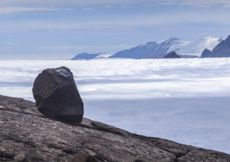Research shows reality of runaway ice loss in Antarctica
A new study led by ARC/SGEES researchers reveals the potential for runaway ice loss in Antarctica.
Dr Richard S. Jones (a current ARC postdoctoral fellow) led a study published in Nature Communications (open access), with his PhD supervisors Associate Professor Andrew Mackintosh, Dr Kevin Norton (SGEES) and Dr Nick Golledge.

By studying rocks at different elevations beside the East Antarctic Ice Sheet (EAIS), the team concluded that a period of rapid glacier thinning occurred in the recent geological past, and persisted for several centuries.
Satellite observations show that parts of the Antarctic ice sheet are currently thinning in response to a warming ocean. Of particular concern is the potential for ‘marine ice sheet instability’, where an initial retreat of ice margins into deepening valleys could lead to continued, unstable ice loss. The new research indicates that the processes leading to instability can be initiated by just minor climate warming.
“The finding is very important for predicting Antarctica’s future contribution to sea-level change,” says Richard. “Particularly when considering that the EAIS contains enough vulnerable ice to raise sea level by tens of metres. It might only require a small amount of climate variation to initiate runaway ice loss, and it could continue for centuries to millennia.”
While this process has been posited for many years, the study presents the first directly recorded evidence that it has taken place in the past, providing new insight into the future behaviour of rapidly changing parts of Antarctica today.
A major strength of the study was combining numerical modelling experiments that simulate glacier retreat with geological data processed in Victoria University’s world-class cosmogenic nuclide laboratory. The laboratory analyses rare isotopes produced through the interaction of cosmic radiation with minerals on the Earth’s surface, which allows for the calculation of the age of a rock surface.
“Most research has previously focused on the West Antarctic Ice Sheet, which makes these observations from East Antarctica all the more significant,” says Richard.
The field work and data collection conducted as part of this study were captured in a video and can be viewed at https://vimeo.com/80447422.
Richard's team were also working with Dr Chris Fogwill from the University of New South Wales Climate Change Research Centre; Dr Peter Kubik and Dr Marcus Christl from the Laboratory of Ion beam Physics in Switzerland; and Sarah Greenwood at the Department of Geological Sciences at Stockholm University.
For more information contact Richard S. Jones on 04-463 5176 or richard.s.jones@vuw.ac.nz
